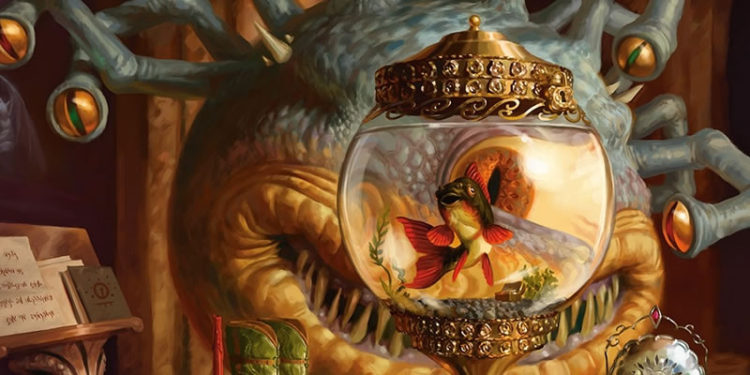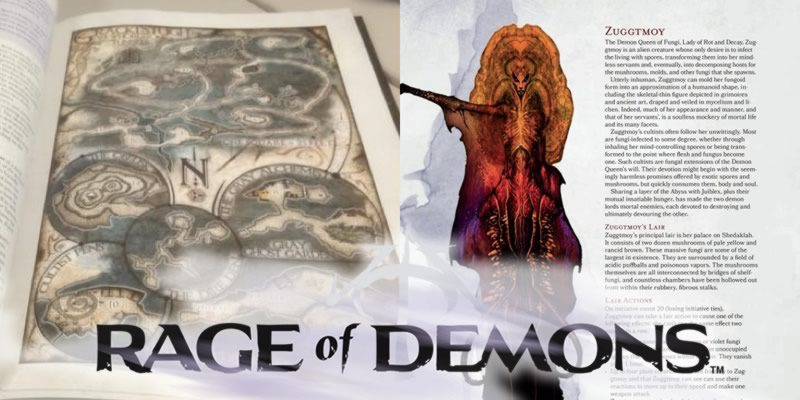Xanathar’s Guide Breakdown, Part Seven

Hey, it’s Part Seven and we’re finally out of Chapter One! I expect Chapter Two to go a good bit faster, as we get into optional rules modules and suggested handling for unusual cases. Still, there’s a lot here, and it’s some of the content I care about most in this book.
Barbarians and Bards | Clerics, Druids, and Fighters | Monks and Paladins | Rangers and Rogues | Sorcerers, Warlocks, and Wizards | Backstory and Feats | Rules Clarifications and Encounter Building
Falling
If you’re falling from a very great height, as with air-to-air combat, you could spend your turn falling and not hit the ground, giving someone time to do something useful. This is particularly important because of the many conditions that can ruin a flyer’s day. They go with 500 feet of falling distance per round, which seems an acceptable handling of the 579.13287401575 feet that an object would fall in the first 6 seconds, ignoring air resistance. (Natural flyers of almost any kind are probably great at air resistance in a fall.)
Then there’s a section that’s specifically about creatures with a flying speed being able to mitigate their fall, even if they can’t halt it completely. Again, given how many ways there are to knock a creature out of the sky, I’m glad this is here, while at the same time I understand why it didn’t merit column-inches in the core books. You can play a whole mess of D&D without ever needing this rule.
Sleep
On principle, you could be forgiven for thinking that the game didn’t really need to make sleep “interesting” with more rules. On the other hand, long rests are a high-stakes business in combat-strewn exploration, so this section drills down a bit on some situations where sleep and waking matter. Two of the three rules here have been relevant to games I’ve played in the past (not specifically 5e).
How do you wake someone up? Well, there are some good, functional rules on that, including multiple specific use cases. If those cases don’t cover whatever’s happening in your game, there’s probably enough guidance that you can make a call. The rule is, in short, approximately what I would have done anyway, if I had had to make a spot ruling.
Can you sleep in armor? This is the part where we all know for sure that they’re just answering some of the most persistent questions they’ve received. Anyway, it’s a wrinkle in the Hit Dice and exhaustion recovery rules. If you’re not trying to recover HD or exhaustion levels, you too can have a stainless steel sleeping bag.
Finally, finally, there are rules for pulling an all-nighter – going 24 or more hours without a long rest. It’s possible to over-correct for the 15-minute adventuring day, y’all! I don’t know how much this one is coming up in games, but I assume it has to do with “until you complete a long rest” effect durations. Anyway, perfectly workable rule here, no complaints.
Adamantine Weapons
This is one of the weird things about 5e magic items: because they don’t proceed from a 3.x-style, materials-driven and a la carte creation system. I love crafting systems, so I’m torn about this as an implementation; on the other hand, I don’t miss the bean-counting and the upgrade optimization of 3.x.
To put that another way, adamantine armor is a magic item that functions in every way like a magic item. Adamantine weapons are not: instead of creating a new magic item (adamantine weapon), there’s a rules block for such weapons. They are not magic weapons, even though all adamantine armor is magic armor, period, end of story. Adamantine weapons are useful if the architecture is the primary aim of your rage, or if you’re also using rules for breaking an opponent’s weapon or armor. (There might be some, somewhere, but I don’t recall them right off.)
The rule here is fine. I am a little put off by the inconsistency of what constitutes a magic item and what not, and by the fact that adamantine weaponry is only situationally useful, while adamantine armor is quite desirable. That is, if you had 50 lb. of adamantine, one suit of armor is probably a better use of the material than 10 weapons, unless your name is Andy Dufresne.
Tying Knots
Use Rope is often derided as among the least useful of 3.x’s skills. To be fair, using rope correctly and in interesting ways isn’t a key part of most fantasy adventure media. (If using rope well is part of your personal fantasy, that is quite another matter and please for God’s sake don’t tell me about it.) Anyway, it’s a variant Sleight of Hand check modified by Int rather than Dex, and it’s opposed by Acrobatics (the universal stand-in for Escape Artist, so sure). There’s nothing wrong with this, though the comment I saw somewhere that rope is a tool and should be a tool proficiency is also a very good point.
Tool Proficiencies
Right off the bat, the text deals with the core problem of tool proficiencies, and I really wish the first few paragraphs here had been in the Player’s Handbook. What do you do when your tool proficiency overlaps in purpose with a skill proficiency? Either grant advantage, or grant additional benefit on a successful roll. That’s a huge benefit and reason to try to fold your tool proficiencies into as many situations as possible. In turn, that’s great for making every non-combat challenge into a vehicle for characterization. It also means that a feat or subclass feature that gives you extra tool proficiencies suddenly looks useful.
There’s one thing that has always been an issue in the skill/tool system, and it’s not resolved here in the least. If you’re proficient in both Performance and a musical instrument, then… free advantage, always? That doesn’t seem right. When would you roll musical instruments for a performance, and not Performance? (The reverse case is a bit more obvious.) I’m not saying D&D needs a whole involved skill challenge system for the PCs to be a hard-rockin’, hard-drinkin’ band, but some clarity around intent here wouldn’t kill them.
Next up, we get detailed guidance on using tools to solve problems in D&D, and skill/tool interactions. Some of the problems the text imagines players solving run a little tedious for my taste – I haven’t seen a lot of investigations hung on remembering infamous poisonings, or ever needed to turn a bitter or sour medicinal concoction sweet – but on the whole they’re fine. The best parts are the full-on new features attached to each tool kit, such as the Prepare Meals feature of cook’s utensils. It’s simple power creep, in that this thing you already had went from doing… maybe nothing… to doing something useful, but it’s still great. Further, there’s DC-setting guidance for each skill, along with some sample tasks.
There are rules for repairing things, aside from the mending spell. Again, it’s not like you can’t play an enormous amount of D&D without ever wanting guidance on that. A confident DM can improvise good solutions to any number of questions the rules decline to answer. There are ways in which creating rules for corner-case situations damages player-DM communication. All that said… once you write rules for damaging objects (especially anything too large for mending), you’re kind of committing yourself to rules for repair.
I have a few issues with individual pieces of this section. Take it as read that the section as a whole is fine and useful. However:
- The description of the calligrapher’s kit hurts me, because my wife is into illuminating manuscripts, and I know a good bit of what she carries as her most basic traveling tools. At minimum, a knife (that is, a penknife – a knife for cutting quills), sand, and a lens for detail work (I’m not the only one here who has seen Name of the Rose, right?).
- No, I don’t think they’re running an arts and crafts sim here, but if you’re going to bother writing this chapter in the first place…
- The special uses of each tool proficiency are not created equal. The Demolition feature of mason’s tools comes up more often and is vastly more satisfying in its ability to change the narrative than the Identify Hides feature of leatherworker’s tools. Vehicle Handling promises to save your bacon in situations that you can go out of your way to create (and should, because death-defying chases are good gaming).
- Decipher Treasure Map is the kind of feature that, if no one has it, the DM is still fairly obligated to give PCs ways to accomplish what it offers. A secret that you can only discover if someone has the right tool proficiency is super hard to implement in a satisfying way, unless you only create such content when you know someone has the feature.
- The Sleight of Hand “feature” attached to the Gaming Set is confusing, and I’m pretty sure they just… forgot to write a unique feature for this proficiency. In fairness, this tool kit’s real function in the game is one of two things: first, to move modest amounts of money between PCs and NPCs (either way), and second, to be a framing device for a scene or story.
- Smith’s Tools includes “sunder a nonmagical metal object: DC 15” among its tasks. Is this intended as a weapon-breaking mechanic for use in combat? Do we really want to open the door of weapon destruction? (Answer: really seriously no.) All the worse if it’s an action you can attempt as often as you like.
Anyway, the Smith’s Tools thing is the biggest issue here, and all it needs is a statement that it’s for unattended nonmagical metal objects. Overall, still a great addition to the game, as it gets players to value pieces of their character’s abilities that were previously unsatisfying and empty. I hope that we’ll see more published content (from WotC, the DM’s Guild, or third-party OGL publishers) that uses the ideas here for more noncombat challenges.
Spellcasting
We’re back to answering frequently asked questions here. It’s roughly two and a half pages of additional rules that would fit into Player’s Handbook Chapter 10: Spellcasting. First off, perceiving spellcasting: the main throughput here is that Innate Spellcasting or Subtle Spell with charm person and greater can create nasty surprises. Other spells, like fireball… well, it doesn’t matter that you aren’t speaking or gesturing, the fireball still visibly comes from you. Anyway, this is fine.
Identifying a spell that you can perceive is the next question, and it hits you right in the action economy. Specifically, you can either know what happened or counter it. Oh, and you could spend your reaction and still fail the Arcana check. The result is that you can’t use this to break the spell slot bid dynamic of counterspell. I have plenty of issues with counter-play at the table, starting with the way PCs usually have a big action-economy advantage over spellcasting enemies, but this doesn’t worsen the problem, at least. You get more mileage out of IDing as an action, outside of combat, to gather information about puzzling magical aftereffects. The whole setup is a substantial boost to wizards, and to bards who go in for Arcana expertise.
Thirdly, how to handle invalid spell targets, which surprisingly enough is my favorite piece of the Spellcasting section. A lot of spells, especially control spells, are target-limited to humanoids (and a few to beasts); what’s the expected handling when you try charm person on a vampire who seems completely human? The answer that I care about here is, “It doesn’t ruin the mystery,” or perhaps, “You can’t use charm person as a litmus test.” There may still be some specific spells that target creatures by type and have a perceptible effect even on a successful saving throw, and those could be litmus tests, but I can’t think what those would be offhand. Anyway, I’m always here for “the mystery isn’t spoiled by something trivial.”
Finally, two different approaches to defining area effects. The Template Model involves cutting out spell overlays – the world’s lowest-fi targeting reticle. The significant change from the Player’s Handbook is that it rejects counting out squares and the oddities of 1 square = 5 feet (even in diagonal distances), which my group knows as the “circles are squares” model from 4e. To be clear, the PH “circles are squares” model is reasonably high-functioning and quick to resolve. I find it a better use of time than 3.x-style counting out diagonals (“5, 15, 20, 30, 35, 45…” was not good for my calm). Still, the template model is a lot friendlier to 360-degree targeting of cones and lines, which I like.
The Token Model looks like the slowest possible approach, and I can only stare at it in befuddlement. It’s tactile, sure, but the examples in the book only show spells that don’t hit anything, and totally miss the fiddly and annoying issues around placing and cleaning up piles of dice, on which you’ve had to balance a bunch of minis. If you’re playing with 2D tokens for characters, this is less bad, but still looks to me like a strange way to get the job done. If you’ve tried this and love it, talk to me in the comments about what you get out of it?
Overall, pretty good stuff in this section; four things I like and one that is very not-for-me. 80% is about the hit rate of everything in the book so far. Thinking back to 2e, 3.x, and 4e splatbooks, only the very best of them even toe the line of 80% interesting-or-useful. That comparison is my overall metric here: not “could some of this content have been stripped out to optimize more for my tastes?” but “how does it compare to the last going-on-30 years of splatbooks?”
Encounter Building
This is a super mathy section, and I think it’s a verbatim reprint (or near enough) of the UA release, so I’m just going to link my breakdown of it. Looks like some of the numbers have been tweaked, but my critiques still hold.
There’s also a new Quick Matchups section, for an extra quick-and-dirty encounter-building tool. It’s also a bit more usable with parties of unequal levels. Pro tip (won from hard experience): encounter design for a spread of more than 1 level is really hard. No table is going to be sufficient, because it’s about getting each character to fight the thing where their abilities (and hit point totals) are sufficient without being overwhelming. Players don’t feel inherently obligated to pair off with the right monster or gang of monsters. They can’t read your mind.
This section is fine. Encounter-building is one of those things that needs to be presented in whatever way best suits the mental architecture of the person reading it. The DMG’s version might not work for everyone, XGTE’s might not work for everyone, but in theory they’re catering to more readers now.
Random Encounters
Somewhat in contradiction to encounter-building guidance, there are 20ish pages of random encounter tables, broken into four separate level bands, for every kind of wilderness, as well as urban environments. I have no idea how to evaluate random encounter tables for someone else to use. There’s a mix of probably-combat, probably-social, and mood-setting visuals in these tables. Some of them are very-likely-lethal if the PCs try to turn them into a fight. They make excellent use of bounded accuracy, keeping the same creatures interesting at higher levels by using larger groups.
The Arctic 11-16 and 17-20 table spawns so many dragons, you’re gonna think you’re in Skyrim Province. Any given roll has a 16% (17-20) or 21% (11-16) chance of being one or more dragons. I admit that I am alarmed to think of running 3 creatures with legendary actions in the same encounter.
The tarrasque appears once (that I see in a quick search) on these tables. The 100 result on the Urban 17-20 table. One presumes you’ll know well in advance when it’s coming, rather than stumbling across it in a dive bar somewhere, nursing a whiskey and wondering how it all came to this.
This whole section is probably fine, and just not really my thing. Even at very high levels, I would have a hard time with a setting where 10% of all encounters are gray slaadi, without an enormous amount of expository foundation or follow-up explanation of what in Limbo they were doing there. It’s the kind of encounter that could easily divert all attention from whatever else is going on, because if there’s a gate to Limbo standing open or something, you have a bad problem and will not go to space today (but you might soon get a firsthand tour of the Fugue Plane).
The best content here, to my mind, is the probably-non-combat stuff: memorable scenery, unsettling sound effects, merchants with goods to sell, an unsubtle reference to the Argonath (yes okay I know that the Argonath are Isildur and Anárion, not elves), and so on. There’s often nothing to engage with directly there, but it’s a reminder of where and how to fold more flavor into a travelogue. Conversely, the least interesting content is the many, many fights with unintelligent creatures. It adds the least to the story, because the encounter premise is typically so bland. (But if you’re the DM who can make something compelling out of that, then good on you.)
The next few sections of this chapter are massive: traps, downtime actions, and magic items. I’m excited, but daunted. It’ll have to wait for the next article in this series. Next week I’ll presumably be covering a new UA article, and following that another adventure review.



